
Summary of my paper written for the 22nd Conference of Students' Scientific Circle

It can be necessary to know the amount of UV-radiation emitted by the Sun or an artificial source for different reasons. The amount of natural UV-radiation strongly depends on the weather conditions, the geographical position and the part of the day. The demand on measuring the UV-radiation has particularly increased since it became widely known that the ozone layer is getting thinner. Figure 1 shows the change of the thickness of the ozone layer.
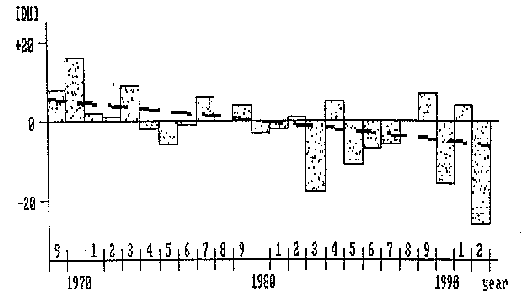
Figure 1.
Change of the thickness of the ozone layer
As well known, the increased UV-radiation can cause serious diseases (e.g., sunburn, early aging of skin, skin cancer, cataracts, etc.). By measuring the intensity of this radiation and avoiding to overdo sunbathing we can protect ourselves from these diseases.
Many instrumental and chemical methods have been available for a long time, but they are not suitable in every respect. The personal dosimeter called SUNTEST, developed at Kossuth University, is one of the bests.
This system is a chemical actinometer, namely suspension of jointly precipitated silver-oxalate/mercurous-oxalate, embedded in gelatin gel. During irradiation the following reactions are thought to take place in the originally white photosensitive layer:


Sensitivity of SUNTEST is high enough to obtain a browning easy to evaluate by eye with a short time irradiation. Its characteristic curve, on the other hand, involves a linear section which is suitable for setting up a comparative table (see Figure 2.).
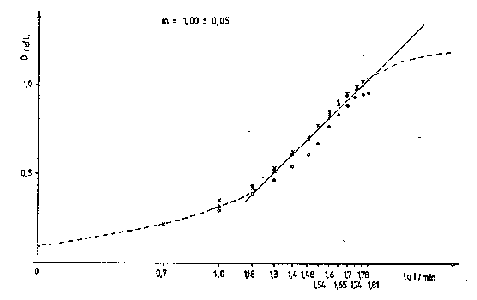
Figure 2.
Characteristic curve of a SUNTEST sample irradiated with sunlight
We can determine the recommended period of sunbathing with the help of SUNTEST on the following way:
A short (1 cm long) strip of the actinometer has to be placed on the sun close to our body. After 5 minutes of irradiation we compare the browning of the layer with an enclosed four-step scale. The recommended period of sunbathing for people with sensitive skin and people with not so sensitive skin can be read from a table next to the scale.
If we want to use an actinometer for measuring the intensity of an unhealthy radiation the spectral sensitivity of the actinometer has to be the same as that of the human skin. On Figure 3 dashed curve represents the spectral sensitivity of SUNTEST and solid curve represents the spectral sensitivity of the human skin. The two sensitivities agree well.
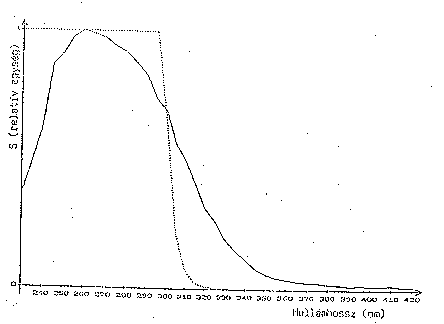
Figure 3.
Spectral sensitivity of SUNTEST (solid curve) and the human skin (dashed curve)
For environmental reasons, because of its "mercury"-content, SUNTEST is not suitable for use by general public in great quantities. Anyway, it can be used well for scientific purposes. In our work -- keeping the good properties of the original SUNTEST -- we wanted to replace the sensitizing mercurous ions with another metal ion with variable valency.
During our experiments we applied the photosensitive material on baritated paper. The sensitive layers were irradiated with sunlight, quartz lamp and solar simulator. We determined the reflection density of the irradiated surfaces and thus determined the characteristic curves and spectral sensitivity of the systems.
On the basis of a well-known actinometer we used ferric-oxalate as sensitizing substance. In this case the following reactions are thought to take place in the photosensitive layer:


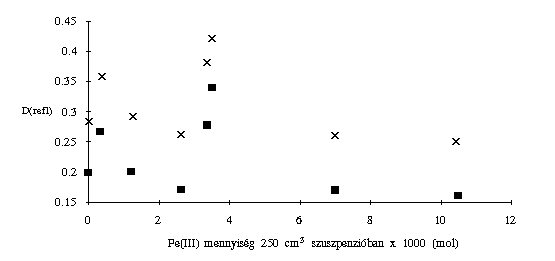
Figure 4.
Connection between the reflexion density (sensitivity) measured after 60 minutes of irradiation and the amount of Fe(III) in 250 ml of suspension
(x: Drefl with veil; o: Drefl without veil)
The quality of the precipitator/ligand was varied, but oxalic acid was found to be the most suitable for this purpose. Sensitivity was found to increase with increasing the amount of oxalic acid. Photosensitivity of ferric complexes formed by other di- or poliacids and aminopoliacids was examined and it was found that some of them are sensitive to UV-radiation. But photochemical systems made with these complexes did not have appropriate characteristic curves.
The pH value of the system influences the sensitivity since it influences the distribution of ferric-oxalate complexes. From this aspect higher pH value would be advantageous but our photosensitive systems are more stable at low pH values.
Varying the amount of ferric ions, the acidity and the amount of oxalic acid we were able to produce systems that are sensitive mostly to UVB radiation, and their sensitivity meets the requirements. Figure 5 shows the characteristic curves of these systems. These characteristic curves are suitable for setting up comparative scales. The relatively low sensitivities of these systems, on the other hand, make it possible to develop a new family of integral chemical actinometers.
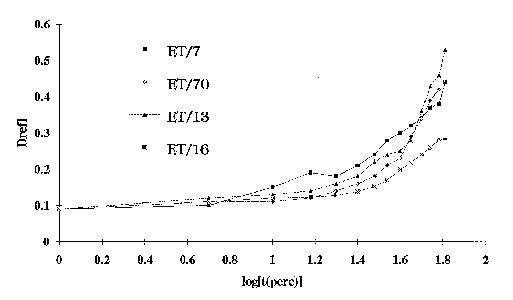
Figure 5.
Characteristic curves of systems containing Fe(III)oxalate
Figure 6 shows the spectral sensitivity of the suspension thought to be the best and the spectral sensitivity of the human skin. The maximum of the sensitivity is in the UVB region actually, but the sensitivity of the suspension in the visible region is not negligible.
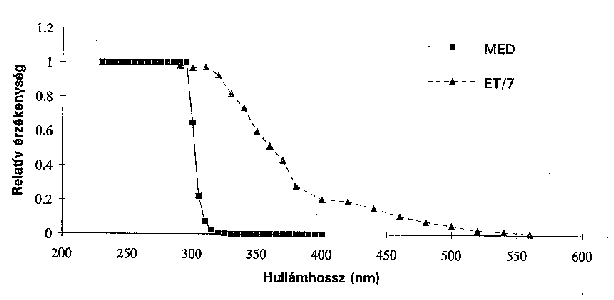
Figure 6.
Spectral sensitivity of a suspension containing Fe(III)oxalate (ET/7) (dashed curve) and the human skin (MED) (solid curve)
By the help of these actinometers the amount of UV-radiation reached the surface in a time unit could be determined easily and quickly. Thus, developing of sunburns or even skin cancers could be avoided.
The lecture was presented on the 22nd Conference of Students' Scientific Circle on 12. April, 1995, in Debrecen, Hungary.
Last modified: 26 March, 2000
Copyright © Attila Nemes, [email protected], Debrecen, 1996-2000. All rights reserved.
URL: http://www.geocities.com/nemes01/szakmai/summary.html